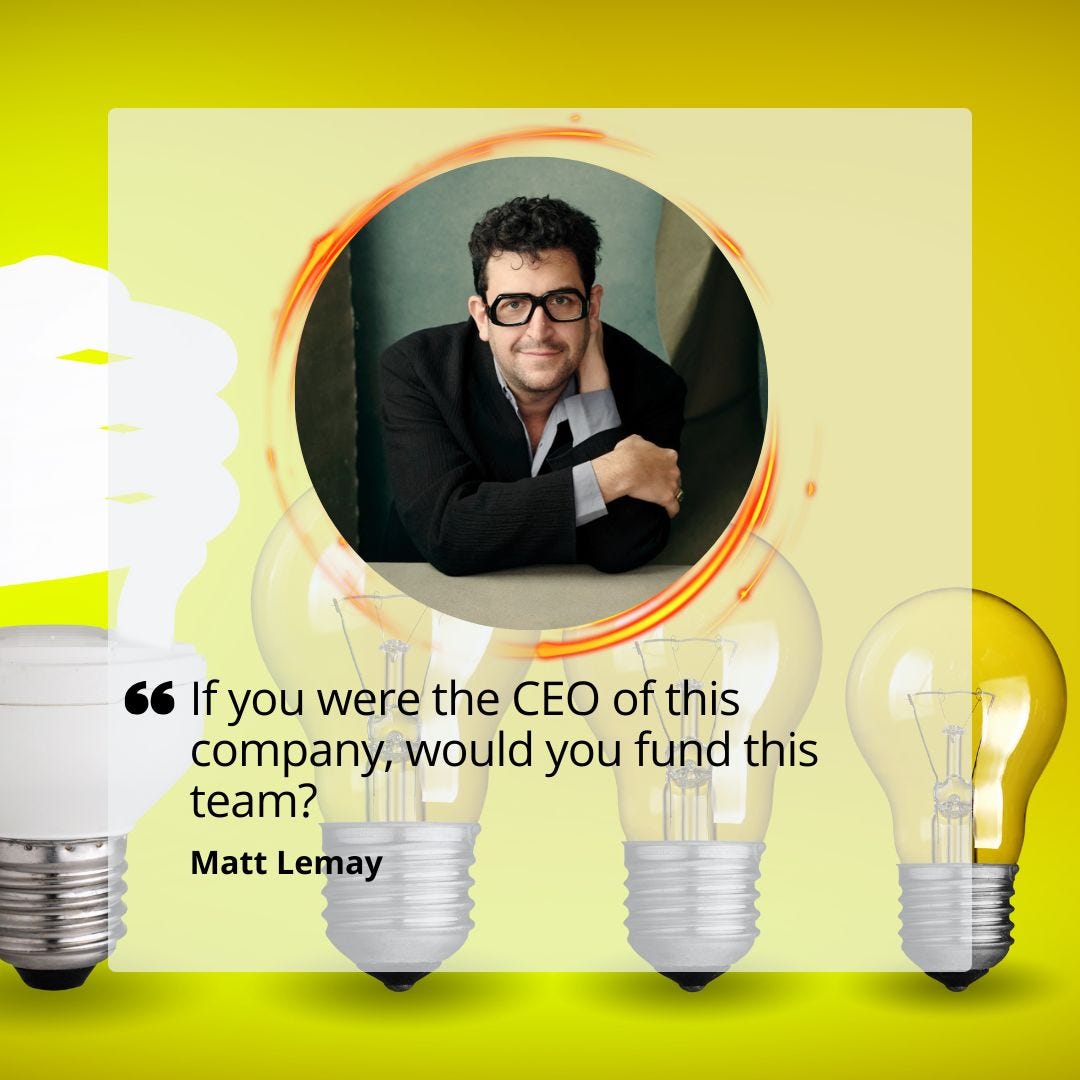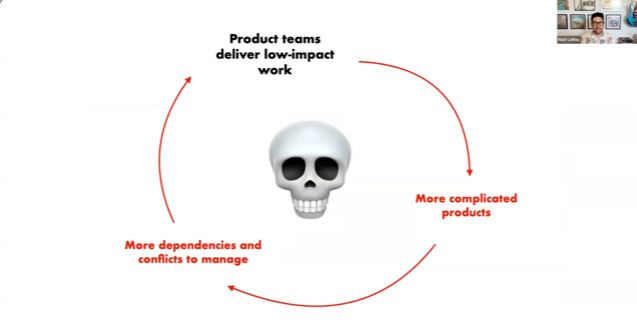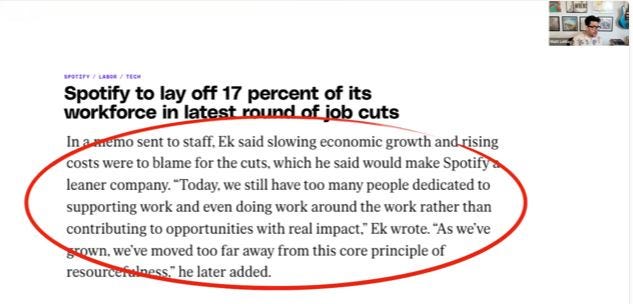💡 Product Circle ⭕ Chat - Impact First Product Teams with Matt LeMay
At 💡 Product Circle ⭕ Chat 47 with Matt LeMay, we learnt why becoming an Impact First Team matters, to never be too far from the company goal and how to avoid the low impact death spiral.
💡Product Circle⭕ Chat runs every second week as a Zoom call that anyone can join to talk all things product, product management and problem solving. Creating value for customers and the business.
Best of all, when you attend live, you receive goodies like free courses and decks (like Janna Bastow provided), a free book (like Rich Mironov, Roman Pichler and others provided), access to their course for free (like John Cutler provided) and many more.
Don’t forget to follow the 💡Product Circle ⭕ Chat calendar on Luma and register for our next talks on
💡 Product Circle ⭕ Chat - Aligning Your Executive Team with Bruce McCarthy on July 3.
💡 Product Circle ⭕ Chat - Outputs to Outcomes with Lea Hickman on July 17.
💡 Product Circle ⭕ Chat - Navigating the Broken PM Job Market with James Gunaca on July 30.
👋I’m Irene Liakos. A product management, change, AI and growth expert with over 2 decades of experience growing product profitably across Telco, Banking, Fintech, AI, Data, Travel, Ecommerce and more. I teach, coach and advise product managers and business leaders. Reach out to me if your products aren’t delivering the value you need. You can contact me at irene@phronesisadvisory.com
Now don’t miss an article, make sure you subscribe!
Let’s get back to Matt’s talk.
"If you were the CEO of this company, would you fund this team?" - Matt LeMay
This 💡Product Circle⭕ Chat was run on the 18 June 2025 at 6pm (AEST) with Matt LeMay.
Recording below👇🏼
But first a summary…
🌀 The Low-Impact Death Spiral: What It Is and How to Escape It
If you’ve ever worked in a product team that’s delivering a lot but still can’t seem to prove its value, you might be caught in what Matt LeMay calls the Low-Impact Death Spiral.
Here’s what it is, how teams get stuck in it, and most importantly how to escape.
🚨 What is the Low-Impact Death Spiral?
The Low-Impact Death Spiral is what happens when a team starts to feel pressure to prove its worth… but doesn’t have a clear, measurable link to business outcomes.
The spiral begins when product teams opt for work that avoids intense scrutiny or potential failure. They choose to add "nice little features" or superficial improvements rather than tackling commercially critical aspects of the business. This is like "bedazzling the hell out of a car" with rhinestones rather than fine-tuning its engine. The appeal of this type of work is that it feels like it "does no harm" and is less risky because it doesn't involve "touching the engine".
All these small, disconnected, and often superficial features make the product increasingly complicated. Matt LeMay describes modern products as often feeling like a "grab bag of disconnected features that don't really serve any purpose".
A more complicated product leads to more internal conflicts and dependencies that need to be managed to build anything meaningful. This makes it harder to "lift the hood of the car" and improve its core functionality because it's "bogged down, weighted down with rhinestones".
As managing complexity becomes more difficult, teams are even less likely to undertake truly impactful work. They revert to doing more low-impact work because it's perceived as easier to do.
This cycle perpetuates itself, leading to a continuous decline in product effectiveness and efficiency, often culminating in layoffs. The CEO of Spotify, for example, noted that many employees were "doing work around the work rather than contributing to opportunities with real impact".
Organisations often misdiagnose the problem, focusing on symptoms rather than the root cause. Instead of recognising that low-impact work is the issue, they perceive the problem as dependencies and look to manage the dependencies with meetings, reorganisations, and adding “better portfolio management”.
The core issue is not these symptoms, but the underlying low-impact work itself, which generates the complexity and friction in the first place.
Ironically, the more the product team does, the harder it becomes to draw a straight line between their work and any tangible business impact. And so the cycle continues: the pressure builds, the activity increases, and the team spins faster into a vortex of “busyness” that feels productive but actually erodes trust and confidence.
Sound familiar?
🔁 How Teams Fall Into the Spiral
According to Matt, most teams don’t enter this spiral because they’re lazy or incompetent. In fact, it’s often the opposite. These are smart, motivated teams that genuinely want to help, but they lack a clear definition of success.
Here are a few common causes:
Misaligned or vague goals (e.g. “Make the user experience better” or “Increase engagement” with no definition of what success looks like)
A culture of delivery over discovery, where shipping is celebrated more than learning
A fear of naming business metrics, often because product teams feel uncomfortable with numbers
Pressure from stakeholders to justify headcount with visible output
And once the spiral starts, it’s self-reinforcing. Stakeholders lose confidence, trust erodes, and the team responds with… even more activity.
🎯 How to Define Success: The Power of High-Impact, High-Specificity Goals
If your team has ever rallied around a beautifully written goal—only to find that six weeks later, no one remembers it, or worse, it didn’t drive any real change—you’re not alone. According to Matt LeMay, most product teams are setting goals that are doomed to fail.
Matt shared a powerful insight:
“Most teams have too many goals—and they’re usually the wrong ones.”
Or are too far removed from the goal.
🧩 Why Most Goals Fail
There’s no shortage of goal-setting tools: OKRs, KPIs, North Star Metrics, SMART goals. But Matt points out that the issue isn’t format. It’s clarity and focus.
Teams fall into these traps:
Too many goals: Everything’s a priority, so nothing is.
Vague goals: “Improve the user experience” or “Increase engagement” are common—but what do they actually mean?
Safe goals: Teams pick what they know they can achieve instead of what moves the needle.
Disconnected goals: There’s no clear link between the goal and a business outcome that matters.
The result?
Teams get busy. They might even hit their targets. But the business impact is fuzzy at best.
🔍 Early Warning Signs You’re in the Spiral
Here’s a quick checklist to help you spot the spiral early:
🚩 Your roadmap is full, but nobody’s sure why you’re building those things
🚩 Success is defined as “shipping on time”
🚩 Metrics are retrofitted after a feature is delivered
🚩 Team morale is dropping, even though you’re “delivering a lot”
🚩 Stakeholders are questioning the product team’s value
If any of these sound like your team, don’t panic. But don’t ignore it either. The spiral doesn’t fix itself.
The Low-Impact Death Spiral is real and it’s dangerous not because it leads to failure overnight, but because it creates the illusion of progress while trust and value quietly erode.
Matt’s message was clear:
👉 Simplify.
👉 Define success.
👉 Focus on outcomes.
👉 Be brave enough to say what matters.
And that’s how you become an impact-first product team.
How One Question Transformed the NHS COVID App and Saved 10,000 Lives
One story from Matt LeMay’s book “Impact-first Product Teams: Define Success. Do Work That Matters. Be Indispensable.” comes from Randeep Sidhu.
In the chaos of early 2020, as COVID-19 swept across the globe, governments scrambled to deploy digital solutions that could help stem the tide. The UK's National Health Service (NHS) was no exception, rushing to develop a contact tracing app that could help reduce virus transmission. But their first attempt was, by all accounts, "a disaster."
Enter Randeep Sidhu, a product leader brought in to salvage what seemed like an impossible situation.
What happened next offers one of the most compelling examples of impact-first product development in recent memory—and a masterclass in how the right question can transform everything.
When Technology Meets Reality
The challenge Randeep faced wasn't just technical. Building a COVID contact tracing app meant aligning an incredibly diverse group of stakeholders: medical professionals who understood the science of virus transmission, government officials navigating political pressures, and technology experts focused on app architecture and user experience.
Each group arrived with their own priorities, their own ideas about what mattered most. Classic product development chaos was brewing, the kind that leads to feature bloat, competing priorities, and ultimately, products that serve no one well.
But Randeep had a different approach.
The Power of One Metric That Matters
Instead of trying to juggle multiple success metrics or letting each stakeholder group pursue their own goals, Randeep made a bold decision. He announced publicly that they would have one metric that matters: reducing the transmissibility of the virus.
Not app downloads. Not user engagement. Not even user satisfaction scores.
Just one question would guide every decision: "How does this help reduce the transmissibility of the virus?"
From Features to Impact
Randeep didn't just declare this metric and move on. He created a process that forced everyone to think differently. In open sessions, anyone could propose an idea for the app, but they had to make a public case for how that idea would specifically help reduce virus transmission.
This simple requirement transformed everything.
Initially, discussions had centered around typical app development concerns: notification architecture, user interface design, and technical performance metrics. These weren't wrong considerations, but they weren't asking the right question.
Once people, including non-technical public health stakeholders, started proposing ideas through the lens of transmission reduction, the focus shifted dramatically.
Discovering What Really Mattered
The magic happened when the team started thinking beyond the app itself. Questions that had never come up in traditional app development suddenly became central:
✅ Language accessibility became a priority. If the app wasn't available in the languages spoken by the most vulnerable communities, how could it reduce transmission in those populations?
✅ Data accessibility emerged as a critical concern. What good was a contact tracing app if people couldn't afford the data to download or use it? The team began exploring partnerships with data providers to make the app "zero-rated"—free of data charges.
✅ Community outreach shifted from an afterthought to a core strategy. Getting the app into the hands of people who needed it most, but might not know about it, became as important as building the app itself.
These insights didn't come from user research or market analysis. They emerged naturally when everyone was forced to connect their work to the core goal of reducing virus transmission.
The Results Speak for Themselves
This approach wasn't just philosophically satisfying—it delivered real-world impact. A study published in "Nature" found that the NHS COVID app likely saved approximately 10,000 lives.
Ten thousand lives. That's not an abstract metric or a vanity number. That's 10,000 families who didn't lose a loved one, 10,000 stories that continued, 10,000 reasons why the right approach to product development matters.
Lessons Beyond the Pandemic
The NHS app story offers profound lessons that extend far beyond public health or pandemic response:
🔥 Clarity creates alignment. When teams have one clear, meaningful goal, diverse stakeholders can find common ground and work toward shared outcomes.
🔥 The right constraint reveals hidden opportunities. By forcing every decision through the filter of transmission reduction, the team discovered critical needs they might never have considered otherwise.
🔥 Impact-first thinking changes everything. When success is measured by real-world outcomes rather than internal metrics, teams naturally expand their thinking beyond their immediate domain.
🔥 Cross-functional collaboration becomes essential. Goals that require deep market and user understanding—goals just outside a team's direct control—force collaboration across disciplines and departments.
The Question That Changes Everything
The NHS story ultimately comes down to one transformative question: "How does this help achieve our core goal?"
In Randeep's case, that goal was reducing virus transmission. In your organisation, it might be helping customers succeed, reducing environmental impact, or improving quality of life for your users.
The specific goal matters less than the discipline of having one clear goal and the courage to filter every decision through that lens.
When teams adopt this approach, when they move from feature-first to impact-first thinking, they don't just build better products. They build products that matter.
And sometimes, they save lives.
Watch the video to learn more 👇
Product Circle Chat 47 - Topic
Topic: Impact First Product Teams
Product Circle Chat 47 - Video
Product Circle Chat 47 - Speaker
Matt LeMay is a globally respected product leader, consultant, and author known for helping teams and organisations maximise their business impact by cutting through complexity and focusing on what really matters. He is the author of Impact-First Product Teams, Agile for Everybody, and Product Management in Practice.
With over a decade of experience, Matt has successfully led product initiatives resulting in acquisitions by Google and Intuit, advised global companies like Spotify, and built high-growth product teams for startups now valued at hundreds of millions.
He’s also the creator of the widely adopted One Page / One Hour Pledge, a practical approach that helps teams minimise busywork and maximise collaboration—used by teams at Amazon, Walmart, Adobe, Disney, and more.
Beyond product leadership, Matt is a musician, recording engineer, and the author of a book on singer-songwriter Elliott Smith. He currently lives in London, England.
In every role, Matt champions simplicity, impact, and real-world results over theoretical perfection—making him one of the most practical and inspiring voices in product today.
You can follow Matt on Linkedin here.
Product Circle Chat - Q&A
❓ How do I get involved?
1. Subscribe to the Product Circle Chat Calendar on Lu.ma and get notified of every 💡 Product Circle ⭕ Chat event
2.Register & Show up - Register to the Product Circle Chat event, block your calendar out and come to the next Chat 📅
3. Share - bring a friend or two who wants to talk all things Product 👯♂️👯♀️
4. Volunteer - volunteer to host or present at one of the future Product Circle Chats 🙋♀️. Drop me an email at irene@phronesisadvisory.com
❓ Will there be more sessions?
Yes. Fortnightly. Every second week.
❓ What if I can’t make the next session or don’t want to miss the next Product Circle chat invite?
Really want to come to the session but 😭 can't make this specific 💡 Product Circle ⭕ Chat?
📆 Get an invite directly into your inbox
👉 Subscribe to the Product Circle Chat Calendar on Lu.ma and get notified of every 💡 Product Circle ⭕ Chat event
💪 We've got you!
❓ Still have Questions?
Talk to me. Send me an email at irene@phronesisadvisory.com
Are you new to Product Management and want to learn from me?
I created a Course. For people new to Product Management.
Aligned it with the Learning Outcomes created by Product greats like Jeff Patton and others. Had it certified by the globally recognised ICAgile.
Choose to spend 2 days learning from me - either face to face or via Zoom - with ICAgile Certified Professional in Product Management (ICP-PDM).
And if you’re looking for a sneaky discount, send me an email at irene@phronesisadvisory.com









